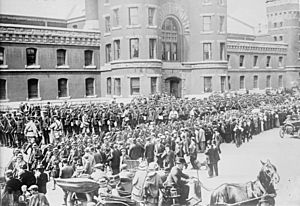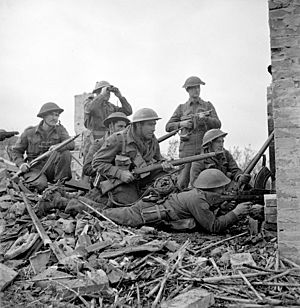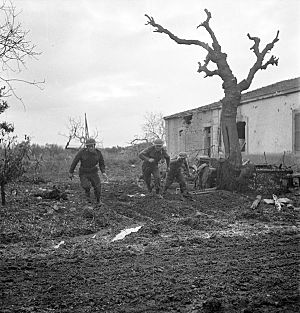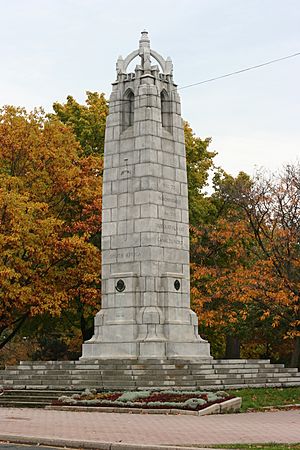48th Highlanders of Canada facts for kids
Quick facts for kids The 48th Highlanders of Canada |
|
|---|---|
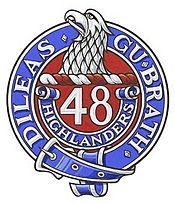
Regimental badge
|
|
| Active | 16 October 1891 – present |
| Country | Canada |
| Branch | Canadian Army |
| Type | Infantry |
| Role | Light infantry |
| Size | 1 battalion |
| Part of | 32 Canadian Brigade Group |
| Garrison/HQ | Moss Park Armoury, Toronto, Ontario |
| Nickname(s) |
|
| Motto(s) | Dileas gu brath (Scottish Gaelic for 'faithful forever') |
| March | "48th Highlanders Slow March"; Quick – "Highland Laddie" |
| Engagements |
|
| Battle honours | See #Battle honours |
| Commanders | |
| Current commander |
LCol T.D. Wentzell. |
| Honorary colonel | HCol S. Darling |
| Regimental sergeant major | CWO M.G. French |
| Notable commanders |
|
| Insignia | |
| NATO Map Symbol |  |
The 48th Highlanders of Canada is a special army group in Canada. It is a Primary Reserve infantry regiment, which means its members are part-time soldiers who train regularly and can be called upon to serve. This regiment is based in Toronto, Ontario, and trains at Moss Park Armoury. It is part of the 4th Canadian Division's 32 Canadian Brigade Group.
Contents
- Regimental Badge
- Regimental History and Name Changes
- Carrying on the Legacy
- What the Regiment Has Done
- A Long and Proud History
- Special Friendships with Other Military Units
- Battle Honours
- Music of the Regiment
- Nicknames: "The Glamour Boys" & "The Dirty Four Dozen"
- Cadet Programs
- 48th Highlanders Museum
- See also
Regimental Badge
The regiment has a special badge that tells its story.
What the Badge Looks Like
The badge shows the number "48" in silver on a red circle. Below it is a blue ribbon with the word "HIGHLANDERS" in silver. All of this is surrounded by a blue belt with the motto "DILEAS GU BRATH" in silver. At the very top, there is a silver falcon's head.
What the Badge Means
The falcon's head comes from the symbol of the Clan Davidson. The regiment's first leader, Lieutenant-Colonel John Irvine Davidson, was from this clan. The main colors, red and blue, are also from the Davidson tartan, which is the special pattern of cloth the regiment wears. The number "48" and the word "HIGHLANDERS" are part of the regiment's name. "DILEAS GU BRATH" is the regiment's motto, which means "faithful forever" in Scottish Gaelic.
Regimental History and Name Changes
The 48th Highlanders of Canada has a long history, starting in 1891. Over the years, its name changed a few times:
- It began on October 16, 1891, as the 48th Battalion Highlanders.
- On May 8, 1900, it became the 48th Regiment Highlanders.
- On May 15, 1920, it was called The 48th Regiment (Highlanders).
- On August 1, 1930, it became the 48th Highlanders of Canada.
- During World War II, on November 7, 1940, it was known as the 2nd (Reserve) Battalion, 48th Highlanders of Canada.
- Finally, on December 31, 1945, it returned to its current name: the 48th Highlanders of Canada.
Carrying on the Legacy
The 48th Highlanders of Canada "perpetuates" the history of three older Canadian army units from the First World War. This means they keep the memory and traditions of these units alive. These units were the 15th Battalion, the 92nd Battalion, and the 134th Battalion, all part of the Canadian Expeditionary Force (CEF).
What the Regiment Has Done
The 48th Highlanders have been involved in many important events throughout history.
South African War
During the Second Boer War (1899–1902), individual soldiers from the 48th Highlanders volunteered to fight with other Canadian groups in South Africa.
The First World War
In World War I (1914–1918), the 15th Battalion, which was part of the 48th Highlanders, was formed in September 1914. They traveled to Britain and then to France in February 1915. This battalion fought bravely in many battles in France and Belgium as part of the 1st Canadian Division.
Other battalions, like the 92nd and 134th, were also formed. They went to Britain to help train and send new soldiers to the Canadian forces fighting in Europe.
The Second World War
During World War II (1939–1945), the regiment quickly got ready for action in September 1939. They were called the 1st Battalion, 48th Highlanders of Canada. They went to Britain in December 1939 and even briefly to France in June 1940.
Later, they played a big part in the fighting in Italy and Sicily in 1943, as part of the 1st Canadian Infantry Division. In 1945, they moved to North-West Europe and continued fighting until the war ended.
A second battalion, the 3rd Canadian Infantry Battalion, was also created in 1945 to prepare for fighting in the Pacific, but the war ended before they were sent.
A Long and Proud History
Since it started in 1891, the 48th Highlanders have been a big part of Toronto's community life. They have taken part in local events for over 100 years, while also serving Canada around the world.
Members of the regiment have helped in many places, including the Golan Heights, Korea, Cambodia, Cyprus, Bosnia, and Afghanistan. Of course, they also fought in both World Wars and the South African War.
The regiment has a special friendship, called an "alliance," with the Royal Regiment of Scotland in the British Army. This friendship is one of the oldest official army alliances in the Commonwealth. Soldiers from both regiments often visit and train with each other.
A memorial was built in Mount Pleasant Cemetery, Toronto to honor soldiers who died in a training exercise in 1912. It also remembers the veterans and soldiers who died in the South African War. Another memorial stands in Queen's Park (Toronto).
The regiment has also performed ceremonial duties, like providing a guard of honor for Queen Elizabeth II in 1998 and for the G7 summit in 1988. Their special "Colour Party" (soldiers who carry the regimental flags) has marched in events across Canada and in the United States.
The regiment's motto, "dileas gu brath," is Scottish Gaelic for "faithful forever." Their special cloth pattern, or tartan, is the Davidson tartan. However, their pipers wear a different tartan called Stewart of Fingask. Queen Elizabeth II was the regiment's colonel-in-chief until her passing on September 8, 2022.
Special Friendships with Other Military Units
The 48th Highlanders have alliances with other military units around the world.
Current Alliances
 United Kingdom – Royal Regiment of Scotland (United Kingdom)
United Kingdom – Royal Regiment of Scotland (United Kingdom) Australia - The Royal Victoria Regiment (Australia)
Australia - The Royal Victoria Regiment (Australia) United States - 48th Infantry Brigade, Georgia Army National Guard (United States)
United States - 48th Infantry Brigade, Georgia Army National Guard (United States)
Past Alliances
 United Kingdom - The Gordon Highlanders (1904–1994)
United Kingdom - The Gordon Highlanders (1904–1994) United Kingdom - The Highlanders (Seaforth, Gordons and Camerons) (1994–2006)
United Kingdom - The Highlanders (Seaforth, Gordons and Camerons) (1994–2006)
Battle Honours
Battle honours are special awards given to military units for their bravery and success in battles. They are often displayed on the regiment's flags.
South African War
First World War
- Ypres, 1915, '17
- Gravenstafel
- St. Julien
- Festubert, 1915
- Mount Sorrel
- Somme, 1916
- Pozières
- Thiepval
- Ancre Heights
- Arras, 1917, '18
- Vimy, 1917
- Arleux
- Scarpe 1917, '18
- Hill 70
- Passchendaele
- Amiens
- Drocourt–Quéant
- Hindenburg Line
- Canal du Nord
- Pursuit to Mons
- France and Flanders, 1915–18
Second World War
- Landing in Sicily
- Valguarnera
- Assoro
- Agira
- Adrano
- Regalbuto
- Sicily, 1943
- Landing at Reggio
- Campobasso
- Torella
- San Leonardo
- The Gully
- Ortona
- San Nicola–San Tommaso
- Cassino II
- Gustav Line
- Liri Valley
- Hitler Line
- Gothic Line
- Lamone Crossing
- Misano Ridge
- Rimini Line
- San Martino–San Lorenzo
- Fosso Vecchio
- Italy, 1943–1945
- Apeldoorn
- North-West Europe, 1945
War in Afghanistan
- Afghanistan
Music of the Regiment
The regiment has a Military Band and a Pipes and Drums band. These bands have a special tradition of playing at every home opening game for the Toronto Maple Leafs hockey team. This tradition started on November 12, 1931, when Conn Smythe, a major in World War I, asked them to play at the opening of the new Maple Leaf Gardens.
Nicknames: "The Glamour Boys" & "The Dirty Four Dozen"
The 48th Highlanders have two fun nicknames: "The Glamour Boys" and "The Dirty Four Dozen."
"The Glamour Boys"
This name came from other regiments during World War II. When King George VI was inspecting the soldiers, the 48th Highlanders had to wear blue leg wraps (called puttees) instead of the usual khaki ones because there weren't enough. The King liked the blue ones and said they should keep them! So, the 48th Highlanders became known for their unique blue puttees, earning them the nickname "The Glamour Boys."
"The Dirty Four Dozen"
This nickname is a clever play on words. It comes from the movie The Dirty Dozen and the fact that "48" is the same as "four dozen."
Cadet Programs
The regiment supports two cadet corps for young people. These programs help teach leadership, citizenship, and physical fitness.
- The 48th Highlanders Royal Canadian Army Cadet Corps is based in the same armoury as the regiment.
- The 142 St. Andrew's College Highland Cadet Corps is in Aurora, Ontario, and is a mandatory activity for students at St. Andrew's College.
48th Highlanders Museum
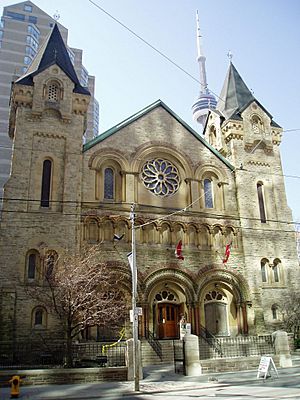 |
|
| Established | 1959 |
|---|---|
| Location | St. Andrew's Church at the comer of King and Simcoe in Toronto |
The 48th Highlanders Museum is located in downtown Toronto, in the basement of St. Andrew's Church. The museum's goal is to collect and share the history of the 48th Highlanders of Canada. It has uniforms, medals, photographs, weapons, and other items that tell the story of the regiment and its members. The museum was founded in 1959 and moved to its current spot in 1997.
See also
- Canadian-Scottish regiment
- Regimental nicknames of the Canadian Forces
- Canadian war memorials
- Toronto Armories


